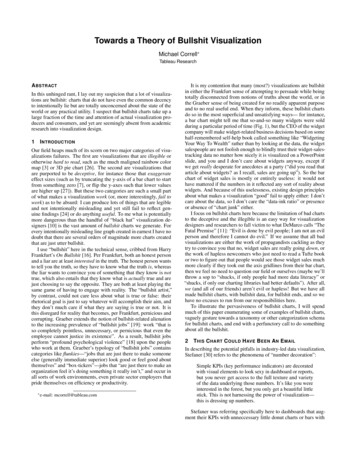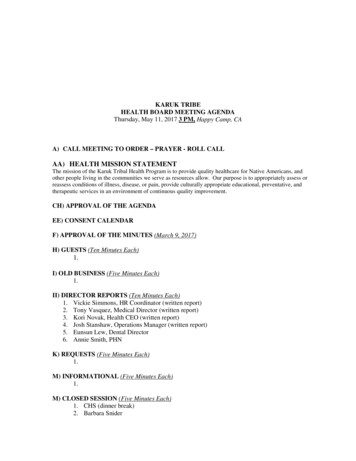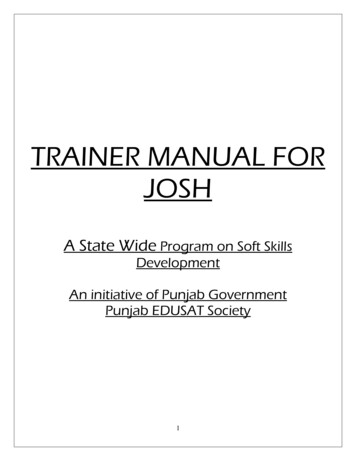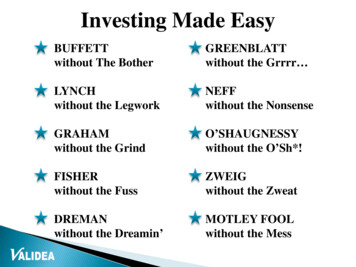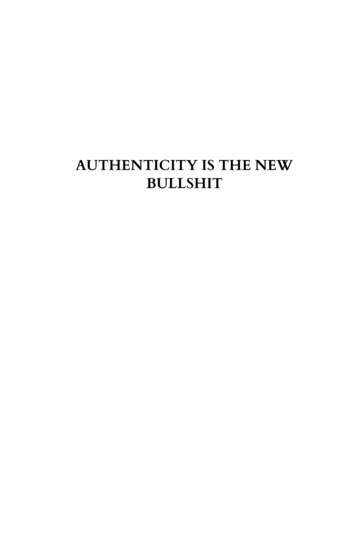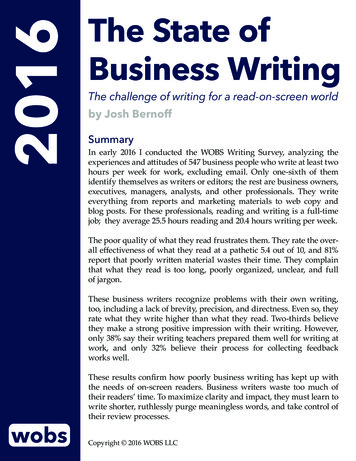
Transcription
2016The State ofBusiness WritingThe challenge of writing for a read-on-screen worldby Josh BernoffSummaryIn early 2016 I conducted the WOBS Writing Survey, analyzing theexperiences and attitudes of 547 business people who write at least twohours per week for work, excluding email. Only one-sixth of themidentify themselves as writers or editors; the rest are business owners,executives, managers, analysts, and other professionals. They writeeverything from reports and marketing materials to web copy andblog posts. For these professionals, reading and writing is a full-timejob; they average 25.5 hours reading and 20.4 hours writing per week.The poor quality of what they read frustrates them. They rate the overall effectiveness of what they read at a pathetic 5.4 out of 10, and 81%report that poorly written material wastes their time. They complainthat what they read is too long, poorly organized, unclear, and fullof jargon.These business writers recognize problems with their own writing,too, including a lack of brevity, precision, and directness. Even so, theyrate what they write higher than what they read. Two-thirds believethey make a strong positive impression with their writing. However,only 38% say their writing teachers prepared them well for writing atwork, and only 32% believe their process for collecting feedbackworks well.wobsThese results confirm how poorly business writing has kept up withthe needs of on-screen readers. Business writers waste too much oftheir readers’ time. To maximize clarity and impact, they must learn towrite shorter, ruthlessly purge meaningless words, and take control oftheir review processes.Copyright 2016 WOBS LLC
The State of Business Writing 20162The WOBS Writing Survey reached a diverse collection of business writers.The survey sample included people who write in English at least two hours per week, excluding email.The respondents’ jobs varied from admins to writers to business owners. Most were college graduates,with a median age of 47 and a median income of 100,000.Most are between 35 and 65.AgeThey come from organizations of all sizes.Number of employees30%17%22%24%22%12%5%2%18 to2425 to3435 to4445 to5455 to6465 NA6%0 to 12 to 1011 to10013%No BS/BA51%Male44%Female101 to1,0001,000 NA5%NA41%Masters/PhDCompensation varies widely.41%BS or BAThey represent diverse industries.5%10%7%7%15%12%16%26%Only one in six is a writer or tive/corp. officerAnalyst/consultantWriter/editorOther professionalOther non-managerNo answer13%Writers are well educated.5%Other/NA1%24%2%They’re balanced by gender.Volunteer/internLess than 25,000 25,000 to 49,999 50,000 to 74,999 75,000 to 99,999 100,000 to 149,999 150,000 to 199,999 200,000 or moreNo answer/not paid in 20%% of respondents29%16%16%16%15%4%3%IndustryTelecom, technology, electronicsBusiness servicesAdvertising & marketingEducationNonprofitGovernmentFinance & financial servicesHealthcare & pharmaceuticalsOther industries/no answer% of respondents19%14%13%12%6%5%4%4%24%One in three is in marketing or PR.DepartmentMarketingPublic relationsResearch & developmentOther departmentNot specified% of respondents27%6%7%31%29%
3The State of Business Writing 2016Reading and writing is a full-time job.People who write for work average 25.5 hours reading per week, plus another 20.4 hours writing.Email accounts for 34% of reading and writing time.Email swallows up managers’ reading time.Hours spent per week readingEmailAllWriter, editorManager, director,supervisorOwner, executive,corporate officerWriters and editors write the most, 28.5 hoursper week.Hours spent per week writingOther reading9.3Email16.2 25.58.418.5 26.911.115.3 26.48.616.7 25.4AllWriter, editorOther writing14.0 20.46.423.2 28.55.3Manager, director,supervisorOwner, executive,corporate officer12.3 20.07.712.0 17.95.9Analyst, consultant8.815.4 24.2Analyst, consultant6.2Other professional8.416.3 24.7Other professional6.113.1 19.310.9 17Business writers create content for a variety of containers.After email, our respondents were most likely to create web copy, memos, and reports. Three-quarters ofmanagers spent time writing memos, while more than half of owners, executives, and corporate officerswrote blogs and social media posts.Writing tasks vary by job description.“What have you written in the last six months?”AllWriter, %100%100%Web site copy62%84%66%78%39%46%Memos (internal)57%44%73%46%51%59%Reports (internal)53%33%69%43%48%60%Tweets (for business)49%58%51%59%50%33%Blog posts48%61%48%66%40%33%Brochures/marketing materials45%57%51%56%30%31%Facebook posts (for business)42%48%41%63%29%37%Reports (external)41%26%43%56%60%23%Manuals or instructions35%32%39%22%33%42%Press %Scripts22%26%24%30%12%20%Owner,executive,corp. officerAnalyst,consultantOtherprofessionalShading indicates job description most likely to create each type of content
The State of Business Writing 20164Writers see many problems in what they read, fewer in what they write.Business writers judge what they read as ineffective, rating it only 5.4 on a 10-point scale. They complainthat writing is too long, poorly organized, unclear, and full of jargon. Like the children in Lake Wobegon,they‘re apparently all above average, seeing fewer flaws in their own work.Written material is ineffective.“On average, how effective is the material you read/write?Rate from 1 (completely ineffective) to 10 (completely effective).”5.4AverageAnalyst/consultant 5.25.7 Writer/editorMaterialyou read45Materialyou write67Manager/director/supervisor 6.66.9Average7.3 Writer/editorText is overlong, disorganized.“In the material you read/write, which of the problems listed here occur frequently enoughto make the material significantly less effective?”Too longPoorly organized65%16%Unclear61%19%Too much jargon54%24%Not precise enough54%32%Not direct enough37%Repetitive25%Poor use of stats24%9%Poor use of graphics11%8%11%Too informal2%9%18%49%34%16%Too much passive voiceNone of these65%45%32%Material you readMaterial you write
5The State of Business Writing 2016While bold and optimistic, writers complain of poor training.Our respondents believe their writing makes a positive impression. The older they are, the less worriedthey are about taking a bold stance. Nearly half worry that reading on screen impairs concentration, andonly 38% feel they got the right writing training in school.Older writers are bolder and more confident.65%63%72%71%“I make a strong, positive impressionon others with my writing.”33%27%26%18%“I worry that taking a clear stand in my writingwould damage my career.”Age18-3435-4445-5455 and olderWriters decry poorly written material and ineffective writing education.81%Poorly written materialwastes a lot of my time.76%67%I make a strong, positive impressionon others with my writing.61%78%48%Reading on a computer/tablet/phonescreen makes it harder to concentrate.48%49%38%My writing teachers in school/collegeprepared me well for writing at work.I worry that taking a clear stand in mywriting would damage my career.84%36%25%52%31%29%Results indicate top two boxes on a 5-point Likert scale of agreement.AllWriters, editorsManagers, directors,supervisors
The State of Business Writing 20166Despite chaotic editorial processes, writers spend limited time on rewrites.Among the writers surveyed, 416, or 76%, worked on writing projects that took at least two weeks tocomplete. They spent 45% of their time on prep and research, but less on rewrites. Only half said theygot the editorial feedback they needed, and only one-third thought their feedback process was effective.Editorial processes are a problem.All49%Writers, editors53%Managers, directors,supervisors41%32%Writers spend only one-fifth of their timeon rewrites.Rewrites19%37%Prep& research45%21%Firstdraft36%I get the editingfeedback I need tomake my writingbetter.Our process forcollecting andcombining feedbackworks well.Based on responses about proportionof time spent on writing stagesResults indicate top two boxes on a5-point Likert scale of agreement.Business writers want to write clearly, but face obstacles“I approve of writing ‘without bullshit’ but ithas infiltrated most corporate writing to thepoint that people don't realize that they arein fact disseminating bullshit.”Consultant, advertising/marketing“I try to fight the good fight against bloatedcorporate content. Sometimes I win.somedays, not so much.”Marketing writer, manufacturing“My biggest obstacle is the clients andconvincing them that a 28-page brochurein size 9 font isn't going to be effective.”Consultant, advertising/marketing“The desire for management to include petphrases or sayings gets in the way of clearcommunication.”Marketing manager, telecom/technology“[I] have to edit [the] boss‘s work for jargon,unclear language, [and] passive voice.”Customer service, telecom/technology“It‘s frustrating the number of people whostill think that writing is more about makingthem sound important than having the readerunderstand the message(s) we are trying tocommunicate.”Marketer, government
7The State of Business Writing 2016Key findings and recommendations.All writers and editors should adopt the Iron Imperative: treat the reader‘s time as more valuable thanyour own. Based on what we‘ve seen in this survey though, business writers continue to have seriousproblems with quality and process, and many imagine their writing is better than it actually is.FindingRecommendationProfessionals spend more than 45 hoursper week on reading and writing.Focus on better writing, from email to reports,to improve corporate productivity.Among business writers, 65% say what theyread is often too long, and 45% say the sameabout what they write.Make brevity in writing a key corporate value.More than half of writers see poor organization,lack of clarity, and jargon as significant problems.Train editors to spot and purge meaninglesswords and replace jargon with plain language.Only 38% of writers say they got proper trainingin school. But among writers over 55, 72% saytheir writing makes a powerful impression.Encourage experienced writers to train andbuild confidence in younger writers.Only 49% of writers working on projects get theeditorial feedback they need, and only 32% saytheir process for collecting and combiningfeedback works well.To make writing processes more efficient,enforce discipline and deadlines on editorsand reviewers.MethodologyThe statistics in this document come from the WOBS Writing Survey, which I conducted from January throughMarch 2016. I recruited survey respondents from several sources. I emailed readers of my blog and people whosigned up for a webinar on clear writing. I also recruited respondents through posts and advertisements on my blog,Twitter, LinkedIn, and Facebook. I used SurveyMonkey to conduct the survey online and analyze the results. To beincluded in the sample set, respondents needed to answer all substantive questions, indicate with their answers thatthey write for two or more hours per week at work (excluding email), and write primarily in English. Of the 793people who responded, 547 fit these criteria. Where I cite a statistic that says that a specific percentage of respondentsbelieve a statement, that statistic indicates the number who checked the top two boxes on a 5-point Likert scale from“completely disagree” to “completely agree.”Where I cite statistics about subgroups, the subgroups have the following sample sizes: writers/editors, 85 respondents; analysts/consultants, 90 respondents; owners/executives/corporate officers, 90 respondents; managers/directors/supervisors, 160 respondents; other professionals, 82 respondents. The statistics on page 6 come from the 416respondents who reported working on a project that lasted more than two weeks within the last year.Because of the way in which I recruited the respondents in this survey, they do not represent a random sample ofAmerican business professionals—the sample is biased toward people who are more concerned about the qualityof writing at work. If this were a random sample, then statistics based on a sample this size would have a marginof error of plus or minus 5% (at a 95% confidence level).
About Josh BernoffI’ve been a professional writerfor 34 years and have authoredor coauthored four books.Groundswell: Winning in a WorldTransformed by SocialTechnologies (HBR Press, 2008)was a bestseller.Photo: Ray BernoffI spent 20 years as an analyst atForrester Research, where I wassenior vice president, ideadevelopment. Since then, I’vededicated myself to eradicatingbullshit in corporate America.Seeking battle-tested writingtips on reports, email, and blogposts? Learn how to write bold,clear, powerful pieces thatgenerate action.Subscribe to my blog atbernoff.com for daily tipsand commentary on effectivebusiness writing.wobsMy new book Writing WithoutBullshit: Boost Your Career bySaying What You Mean is available September 2016. Seebernoff.com/book.bernoff.comLearn more
BS or BA 41% Masters/PhD 13% No BS/BA 5% NA Volunteer/intern Less than 25,000 25,000 to 49,999 50,000 to 74,999 75,000 to 99,999 100,000 to 149,999 150,000 to 199,999 200,000 or more No answer/not paid in 1% 26% 7% 7% 16% 12% 15% 10% 5% Industry Telecom, technology, electronics Business services A

